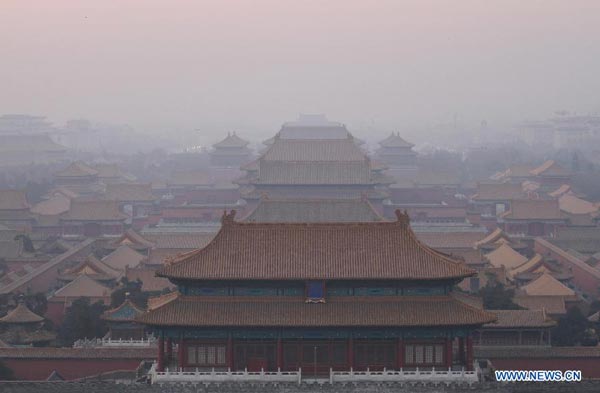

 |
| The Palace Museum, or the Forbidden City, is shrouded in smog in Beijing, capital of China, Jan. 4, 2015. China's top meteorological authority forecast medium to severe smog in the country's northern regions including Beijing and Tianjin as well as the neighboring Hebei Province on Sunday. Meanwhile, smoggy weather will also affect the country's eastern province of Jiangsu as well as the southwestern province of Sichuan on Sunday. (Xinhua/Liu Xianguo) |
Exhaust fumes, factories, coal-burning and dust are the main sources of air pollution in most cities, accounting for 85 to 90 percent of the total pollutant source, said Wu Xiaoqing, vice minister of Environmental Protection, at a national environmental monitoring conference on Wednesday, cyol.net reported.
The analysis of air pollution sources in nine monitoring cities shows that car emissions are the main source of smog in Beijing, Hangzhou, capital of East China's Zhejiang province and Guangzhou and Shenzhen in South China's Guangdong province.
Coal-burning is the main contributor to air pollution in Shijiazhuang, North China's Hebei province and Nanjing, East China's Jiangsu province, while dust and industrial production are responsible in Shanghai, Tianjin and Ningbo, East China's Zhejiang province.
Beijing on Monday released an updated emergency planstating that if heavy smog persists for more than three days the city will launch top-level emergency efforts to reduce pollutants, including restricting the use of private vehicles based on odd-and-even license plates.
 J-11 fighters in air exercise
J-11 fighters in air exercise Beauties dancing on the rings
Beauties dancing on the rings Attendants-to-be join Mr. & Miss Campus Contest
Attendants-to-be join Mr. & Miss Campus Contest Beijing's toughest anti-smoking law takes effect
Beijing's toughest anti-smoking law takes effect Family lives in cave for about 50 years in SW China
Family lives in cave for about 50 years in SW China PLA soldiers operating vehicle-mounted guns in drill
PLA soldiers operating vehicle-mounted guns in drill Blind carpenter in E China's Jiangxi
Blind carpenter in E China's Jiangxi China hosts overseas disaster relief exercise for the first time
China hosts overseas disaster relief exercise for the first time 20 pairs of twins who will become flight attendants in Sichuan
20 pairs of twins who will become flight attendants in Sichuan Obama is sowing discontent in S.China Sea
Obama is sowing discontent in S.China Sea Rescuers work through night to reach cruise ship survivors
Rescuers work through night to reach cruise ship survivors Driving through limbo
Driving through limbo Facing down MERS
Facing down MERSDay|Week